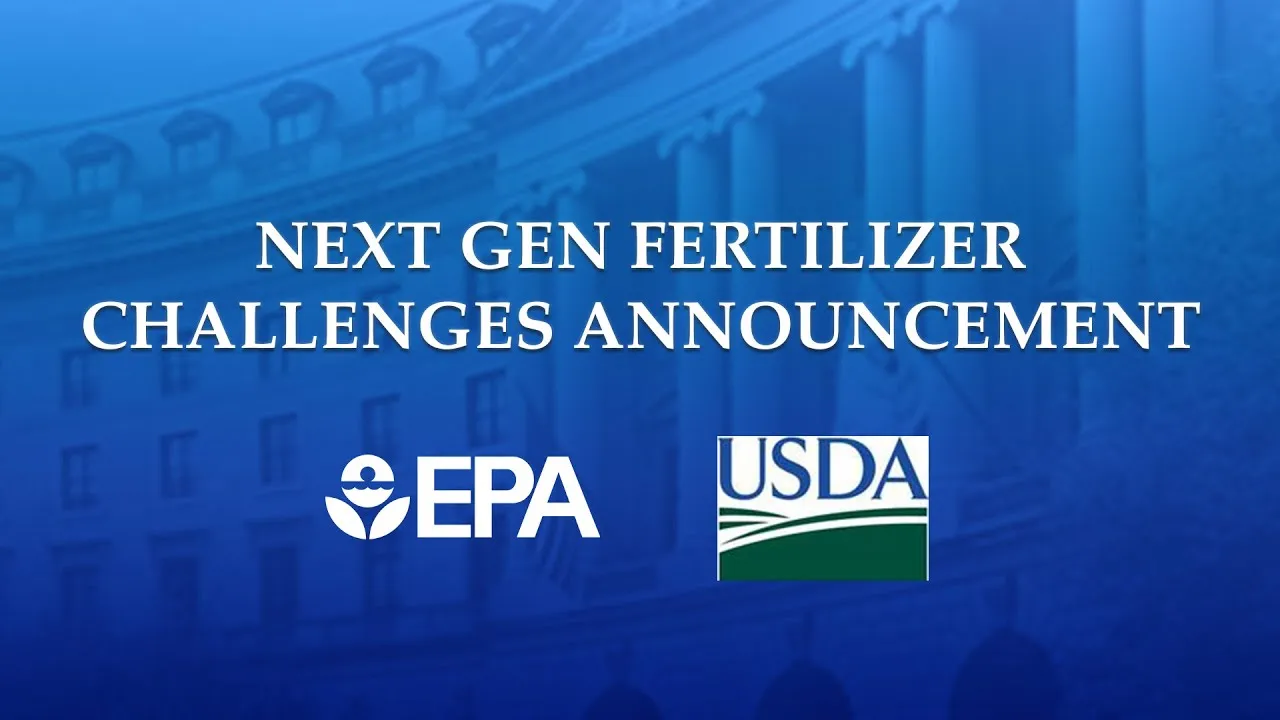


Министерство сельского хозяйства США и Агентство по охране окружающей среды США объявляют победителей конкурса инноваций в области удобрений следующего поколения
ВАШИНГТОН, 19 октября 2021 г. - Сегодня Министерство сельского хозяйства США и Агентство по охране окружающей среды США (EPA) объявили победителей конкурса Next Gen Fertilizer Innovations Challenge, второго из двух частей совместного партнерства и конкурса USDA-EPA по удобрениям повышенной эффективности (EEF) для повышения устойчивости сельского хозяйства в США. Цель конкурса - повысить эффективность удобрений для повышения урожайности при одновременном снижении воздействия удобрений на окружающую среду.

Победители конкурса представили концепции новых технологий, которые могут снизить воздействие азота и фосфора на окружающую среду от современного сельского хозяйства, сохраняя или увеличивая урожайность. Победившие решения используют наночастицы, которые требуют меньше удобрений и выделяют питательные вещества по требованию растущих растений, а затем биоразлагаются до безвредных веществ или даже питательных веществ; поддерживают больший рост растений при том же или меньшем применении удобрений; и другие подходы.
“Farmers, ranchers, and foresters are well-positioned to be leaders in tackling climate change through technological innovation,” said Acting USDA Chief Scientist Hubert Hamer. “Through programs like the Next Gen Fertilizer Innovations Challenge, USDA is partnering with the private sector to find new climate-smart solutions that are good for farmers and good for the environment.”
“The goal of the challenge is to develop and use innovative and affordable technologies to reduce environmental impacts of modern agriculture on our air, land, and water, while maintaining agricultural productivity and profitability,” said Wayne Cascio, acting principal deputy assistant administrator for science for EPA’s Office of Research and Development. “We are excited about the possibilities and continued new work in this area.”
The winning concepts include a range of solutions that can improve environmental outcomes, including reduced nitrous oxide emissions—the largest source of greenhouse gas emissions from agriculture— while maintaining or increasing crop yields.
Среди победителей:
Решения уровня 1 (приз 17 500 долларов США):
Доктор Кристофер Хендриксон, Aqua-Yield Operations LLC, Дрейпер, штат Юта, за нано-умное удобрение.
Taylor Pursell, Pursell Agri-Tech, Sylacauga, Ala., for “Urea 2.0,” which replaces the conventional urea core with a customizable mixture of materials to provide fertilizers tailored to local needs.
Решения 2-го уровня (приз 10 000 долларов США):
Доктор Куиде Цинь, Verdesian Life Sciences, Кэри, Северная Каролина, за использование инновационных технологий смешивания для улучшения характеристик стандартного в отрасли нитрапирина для более длительной эффективности, меньшего вымывания нитратов и предотвращения коррозии сельскохозяйственного оборудования.
Dr. Catherine Roue, Fertinagro Biotech International, Portage, Mich., for “Phosphate Liberation Booster” technology, which uses secretions from phosphate-starved plants to boost plant uptake so less fertilizer may be added and legacy phosphorus can be accessed.
Chandrika Varadachari, Agtec Innovations Inc., Los Altos, Calif., for “Smart-N,” which is a smart-fertilizer that releases nutrients on-demand by the crop and which creates a chemical “cage” for urea that dissolves into plant nutrients.
Решения уровня 3 (почетное упоминание):
Доктору Ярославу Нислеру, Институт экспериментальной ботаники Чешской академии наук, Чешская Республика, за использование производных гормона роста растений MTU, которые способствуют увеличению периодов роста, защите от стресса, получению более крупных растений и потенциально меньшим потерям питательных веществ на единицу внесенного удобрения.
Dr. Leanne Gilbertson, Civil and Environmental Engineering Department at the University of Pittsburgh, Penn., for creating a “protected fertilizer package,” which can carry nutrients through soil pores to the area around the plant roots.
Dr. Robert Neidermyer, Holganix LLC, Aston, Penn., for “Bio 800+,” a microbial inoculant that harnesses the power of over 800 species of soil microbes, kelp, and other soil amending ingredients to promote greater crop production and plant health.
Paul Mullins, Brandon Products Ltd., Ireland, for “BBS-1,” a biostimulant derived from seaweed extract that is applied as a fertilizer coating to improve nitrogen-uptake in root cells.
Министерство сельского хозяйства США и Агентство по охране окружающей среды координируют задачи EEF с Институтом удобрений (TFI), Международным центром разработки удобрений (IFDC), Организацией охраны природы (TNC) и Национальной ассоциацией производителей кукурузы (NCGA).
The competition launched on August 26, 2020. Part two of the first challenge, “EEFs: Environmental and Agronomic Challenge,” is ongoing. More information can be found at: www.epa.gov/innovation/next-gen-fertilizer-challenges.
USDA touches the lives of all Americans each day in so many positive ways. In the Biden-Harris Administration, USDA is transforming America’s food system with a greater focus on more resilient local and regional food production, fairer markets for all producers, ensuring access to safe, healthy and nutritious food in all communities, building new markets and streams of income for farmers and producers using climate smart food and forestry practices, making historic investments in infrastructure and clean energy capabilities in rural America, and committing to equity across the Department by removing systemic barriers and building a workforce more representative of America. To learn more, visit www.usda.gov.
-
Zinc Chloride: a reliable stabilizer for ice dye color salts in the dye industryНовостиAug.11,2025
-
Propargyl Alcohol: A Multifunctional Chemical Additive in the Industrial FieldНовостиAug.11,2025
-
Phosphorus Pentasulfide: a special material that combines moisture absorption and basic chemical valueНовостиAug.11,2025
-
Natural Pesticides: The Environmental Choice for Green Prevention and ControlНовостиAug.11,2025
-
Grass Pesticide: the invisible guardian of green lawnsНовостиAug.11,2025
-
Dimethyl Sulfoxide: Key Assistance in Sample Management and Drug ScreeningНовостиAug.11,2025
-
Uncover the Benefits of Sodium ChlorateНовостиJun.24,2025


















